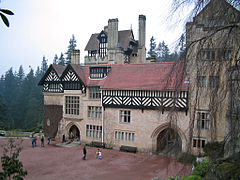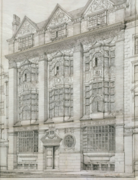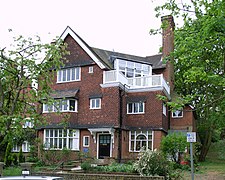Richard Norman Shaw
Norman Shaw | |
|---|---|
 | |
| Born | Richard Norman Shaw 7 May 1831 |
| Died | 17 November 1912 London, England, United Kingdom of Great Britain and Ireland |
| Occupation | Architect |
Richard Norman Shaw RA (7 May 1831 – 17 November 1912), also known as Norman Shaw, was a British architect who worked from the 1870s to the 1900s, known for his country houses and for commercial buildings. He is considered to be among the greatest of British architects; his influence on architectural style was strongest in the 1880s and 1890s.[1]
Early life and education[]
Shaw was born 7 May 1831 in Edinburgh, the sixth and last child of William Shaw (1780-1833), an Irish Protestant and army officer, and Elizabeth née Brown (1785-1883), from a family of successful Edinburgh lawyers. William Shaw died 2 years after his son's birth, leaving debts. Two of Shaw's siblings died young and a third in early adulthood. The family lived first in Annandale Street and then Haddington Place. Richard was educated at an academy for languages, located at 3 and 5 Hill Street Edinburgh until c.1842, then had one year of formal schooling in Newcastle, followed by being taught by his sister Janet. The eldest surviving child Robert had moved to London to work; the rest of the family followed about 1846, living in Middleton Road, Dalston. Richard began his apprenticeship almost immediately at an unknown architect's practice. By 1849, he had transferred to the London office of sixty-year-old William Burn, [2] at whose practice Shaw remained for five years. He attended the evening lectures on architecture given at the Royal Academy of Arts by Charles Robert Cockerell.[3] He met William Eden Nesfield at the Royal Academy, with whom he briefly partnered in some architectural designs. During 1854–1856, Shaw travelled with a Royal Academy scholarship, collecting sketches that were published as Architectural Sketches from the Continent, 1858. On his return to London he moved to George Edmund Street's practice.[4]
Practice and later life[]
In 1863, after sixteen years of training, Shaw opened a practice for a short time with Nesfield. In 1872, he was elected an Associate of the Royal Academy.[4]
Shaw worked, among others, for the artists John Callcott Horsley and George Henry Boughton, and the industrialist Lord Armstrong. He designed large houses such as Cragside, Grim's Dyke, and Chigwell Hall, as well as a series of commercial buildings using a wide range of styles.[4][1]
Shaw was elected to the Royal Academy in 1877,[4] and co-edited (with Sir Thomas Jackson RA) the 1892 collection of essays, Architecture, a profession or an Art?.[5] He firmly believed it was an art. In later years, Shaw moved to a heavier classical style which influenced the emerging Edwardian Classicism of the early 20th century. Shaw died in London, where he had designed residential buildings in areas such as Pont Street, and public buildings such as New Scotland Yard.
Shaw's early country houses avoided Neo-Gothic and the academic styles, reviving vernacular materials like half timber and hanging tiles, with projecting gables and tall massive chimneys with "inglenooks" for warm seating. Shaw's houses soon attracted the misnomer the "Queen Anne style". As his skills developed, he dropped some of the mannered detailing, his buildings gained in dignity, and acquired an air of serenity and a quiet homely charm which were less conspicuous in his earlier works; half timber construction was more sparingly used, and finally disappeared entirely.[4][6]
In later life he lived at 6 Ellerdale Road, Hampstead, London.[7][8] He died in London and is buried in St John-at-Hampstead Churchyard, Hampstead, London.[9]
Bedford Park, London[]
One of Shaw's major commissions was the planning and designing of buildings for Bedford Park, London. Shaw was commissioned in 1877 by Jonathan T. Carr though his involvement only lasted until 1879.[10] He designed St Michael and All Angels, Bedford Park, as the Anglican parish church for the development.
Built work[]
| Place | Location | County | Date | Listed | hideNotes |
|---|---|---|---|---|---|
| Holme Grange School | Wokingham | Berkshire | 1883 | ||
| Greenham Lodge | Berkshire | ||||
| Highdown School | Emmer Green, Reading | Berkshire | 1878–80 | ||
| Dawpool | Cheshire | Demolished 1927. | |||
| All Saints’ Church, Youlgreave | Youlgreave | Derbyshire | 1869 - 1870 | Restoration. | |
| St Giles' Church | Longstone | Derbyshire | 1872-73 | Restoration. | |
| Flete House | Devonshire | ||||
| House of Bethany | St. Clement's Road, Bournemouth | Dorset | 1874–75 | ||
| Bryanston School | Dorset | 1898 | |||
| Bannow | Residential Care Home, St Leonards-on-Sea | East Sussex | 1877 | ||
| Baldslow Place | St Leonards-on-Sea | East Sussex | 1888 | Originally the Ebden family home, now Claremont School. | |
| Chigwell Hall | Chigwell | Essex | 1876 | The building is now owned by the Metropolitan Police. | |
| St John's Church | Boxmoor | Hertfordshire | 1874 | Grade II listed church. | |
| Flora Fountain | Mumbai | India | 1864 | ||
| Alcroft Grange | Tyler Hill, Canterbury | Kent | 1880s[11] | Now divided into 4 wings.[12] | |
| Swanscombe Church | Kent | ||||
| 4 – 6 Page Heath Lane | Bickley | Kent | 1864 | ||
| The Corner House | 114 Shortlands Road, Beckenham | Kent | 1869 | ||
| Hillside | Groombridge | Kent | 1871 | Grade II Listed, considered most typical of his work in Kent[13] | |
| Bailiff's Cottage | Bromley Palace Estate, Bromley | Kent | 1864 | Demolished. | |
| Town Hall | Market Square, Bromley | Kent | 1863 | Unexecuted. | |
| Albion House | James Street | Liverpool | 1896–98 | ||
| 1–2 St. James Street | London | 1882–83[14] | |||
| Grim's Dyke | Harrow | London | 1870 | II[15] | |
| New Zealand Chambers | Leadenhall Street | London | 1871–73[14] | Destroyed by enemy action, WWII. Featured Ipswich windows. | |
| Lowther Lodge | Kensington | London | 1873–75 | Headquarters of the Royal Geographical Society. | |
| 6 Ellerdale Road | Hampstead | London | Built for himself. | ||
| 8 Melbury Road | Kensington | London | 1872–73[16] | Built for painter Marcus Stone. | |
| Woodland House | 31 Melbury Road, Kensington | London | 1876–77[16] | Built for painter Luke Fildes. | |
| Swan House | 17 Chelsea Embankment | London | 1875–77 | ||
| Ellern Mede | 31 Totteridge Common, Barnet | London | 1877 | ||
| Bedford Park | Chiswick | London | 1879–82 | The first "garden city" suburban development: housing, including St. Michael and All Angels Church. | |
| Albert Hall Mansions | Kensington Gore | London | 1879–86 | ||
| Tabard Hotel | Chiswick | London | 1880 | II* | |
| Bolney House | Kingston House estate, London Knightsbridge | London | 1883 | Demolished in the 1960s. | |
| Norman Shaw Buildings | Thames Embankment | London | 1887–1906 | Originally built as the new headquarters of the Metropolitan Police, and the first location to be known as New Scotland Yard. The two buildings are now used as Parliamentary offices. | |
| Kate Greenaway House | Frognal | London | 1885 | ||
| 1 St. James's Street | London | 1904 | |||
| Trevanion | Totteridge Lane, Barnet | London | 1883–84 | ||
| Piccadilly Hotel | Piccadilly Circus | London | 1905–08 | His last work. | |
| Gatehouse to Banqueting Hall | Jesmond Dene | Newcastle upon Tyne | 1869-1870 | ||
| Cragside | Rothbury | Northumberland | 1869/1870–1885 | The first house in the world to be lit by hydroelectricity; built for Lord Armstrong. | |
| Chesters | Northumberland | ||||
| Preen Manor | Shropshire | ||||
| Adcote | Little Ness | Shropshire | 1876–81 | ||
| Knight's Bank | Farnham | Surrey | 1868 | Demolished 1932. | |
| Pierrepont and Merrist Wood | Surrey | ||||
| Pierrepont House | Frensham | Surrey | 1876–78 | ||
| Alderbrook Park | Cranleigh | Surrey | 1881 | Demolished 1956 - house for Pandeli Ralli. | |
| Leyswood | Withyham | Sussex | 1866–69 | ||
| Bannow | St. Leonard's | Sussex | 1877–79 | Private house, now nursing home. | |
| Withyham | Sussex | 1867 | |||
| Gorehill | Petworth | West Sussex | 1871 | ||
| Hammerwood, Nr East Grinstead | West Sussex | 1872[17] | II[18] | Formerly the village school. | |
| Wispers | West Sussex | 1874–76 | |||
| White Lodge and White Lodge West | Bingley | West Yorkshire | |||
| Bradford City Hall extension | Yorkshire | 1909 | |||
| Holy Trinity Church | Bingley | Yorkshire | 1866–68 | Demolished 1974. |
Gallery[]

Cragside, Northumberland, 1869

St. Michael and All Angels, Bedford Park, 1879

Norman Shaw Buildings, London. 1887

Design for New Zealand Chambers, London. 1873

Lowther Lodge, headquarters of the Royal Geographical Society, 1873
Adcote, Shropshire, 1876
Grim's Dyke, Harrow, London, 1870

Hillside, Groombridge 1871

Chigwell Hall, Essex, 1876

1–2 St. James Street, London, 1882–83

House for Kate Greenaway in Frognal, 1885
See also[]
References[]
- ^ Jump up to: a b "Richard Norman Shaw". www.victorianweb.org. 18 November 2015. Retrieved 7 December 2018.
- ^ page 14, Richard Norman Shaw, 2010, Andrew Saint
- ^ page 15, Richard Norman Shaw, 2010, Andrew Saint
- ^ Jump up to: a b c d e Chisholm 1911.
- ^ Richard Norman Shaw, editor: Architecture: A profession or an art: thirteen short essays on the qualifications and training of architects, London, Murray, 1892. Contributors include: R. Norman Shaw, J. T. Micklethwaite, Reginald Blomfield, G.F. Bodley, Mervyn Macartney, Ernest Newton, Edward S. Prior, John R. Clayton, Basil Champneys, W.R. Lethaby, W.B. Richmond, Gerald Horsley and T.G. Jackson.
- ^ Hill, Rosemary (29 March 2008). "Rosemary Hill on the architect Richard Norman Shaw". The Guardian. ISSN 0261-3077. Retrieved 7 December 2018.
- ^ "Richard Norman Shaw". Blue Plaques Guide. Retrieved 9 December 2018.
- ^ "Richard Norman Shaw's house, 6 Ellerdale Road, Hampstead, London | RIBA". RIBApix. Retrieved 9 December 2018.
- ^ "Norman Shaw". Find a Grave. Retrieved 9 December 2018.
- ^ page 2, Bedford Park the first Garden Suburb, 1975, T. Affleck Greeves
- ^ John Martin. "Y900003 / Youth Hostels Association (England and Wales) / Historical listing of all youth hostels and associated accommodation" (PDF). Retrieved 22 November 2016.
- ^ "Check out this property for sale on Rightmove!". Rightmove.co.uk. Retrieved 5 June 2017.
- ^ Newman, John (1983). North East and East Kent (The Buildings of England, 39) (Third ed.). Penguin Books. p. 117. ISBN 9780140710397.
- ^ Jump up to: a b John Bold; Tanis Hinchcliffe; Scott Forrester (27 January 2009). Discovering London's Buildings: With Twelve Walks. frances lincoln ltd. pp. 105–. ISBN 978-0-7112-2918-1. Retrieved 1 July 2012.
- ^ Historic England. "GRIMSDYKE, Harrow (1079676)". National Heritage List for England. Retrieved 5 June 2017.
- ^ Jump up to: a b "Survey of London: volume 37: Northern Kensington". British History Online. Retrieved 28 June 2012.
- ^ Nikolaus Pevsner (ed Iain Nairn); The Buildings of England, Sussex; Penguin, 1965
- ^ Historic England website; number 1028407
- Attribution
- This article incorporates text from a publication now in the public domain: Chisholm, Hugh, ed. (1911). "Shaw, Richard Norman". Encyclopædia Britannica (11th ed.). Cambridge University Press.
Sources[]
- T. Affleck Greeves, "Bedofrd Park the first Gaden Suburb". Anne Bingley, 1975. ISBN 0851575145.
- Andrew Saint, Richard Norman Shaw, revised edition, 2010.ISBN 978-0-300-15526-6.
- Hitchcock, Henry-Russell. Architecture: Nineteenth and Twentieth Centuries. 2nd ed. Baltimore: Penguin Books, 1963. ISBN 9781258016258
- Jones, Edward, & Christopher Woodward. A Guide to the Architecture of London. 2nd ed. London: Weidenfeld & Nicolson, 1992 ISBN 9781780224930
- Norman Shaw's Letters: A Selection, Architectural History, Vol. 18 (1975), pp. 60–85, Published by: SAHGB Publications Limited, DOI: 10.2307/1568382
External links[]
| Wikimedia Commons has media related to Richard Norman Shaw. |
- Great Buildings on-line: Richard Norman Shaw
- Illustrations of Adcote
- Flickr photoset
- Archiseek: Richard Norman Shaw
- 19th-century British architects
- 1831 births
- 1912 deaths
- Architects from Edinburgh
- Royal Academicians
- British ecclesiastical architects











